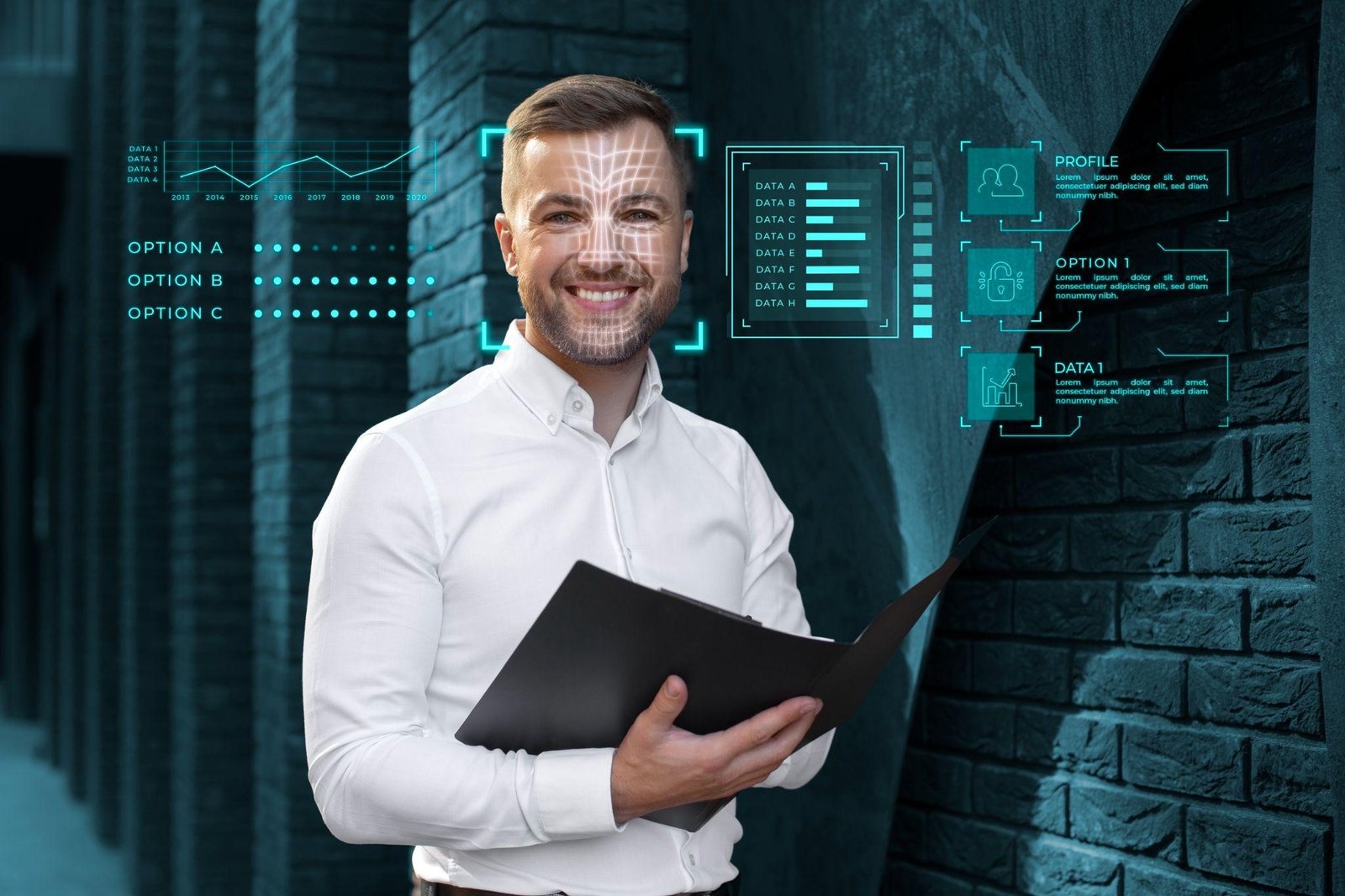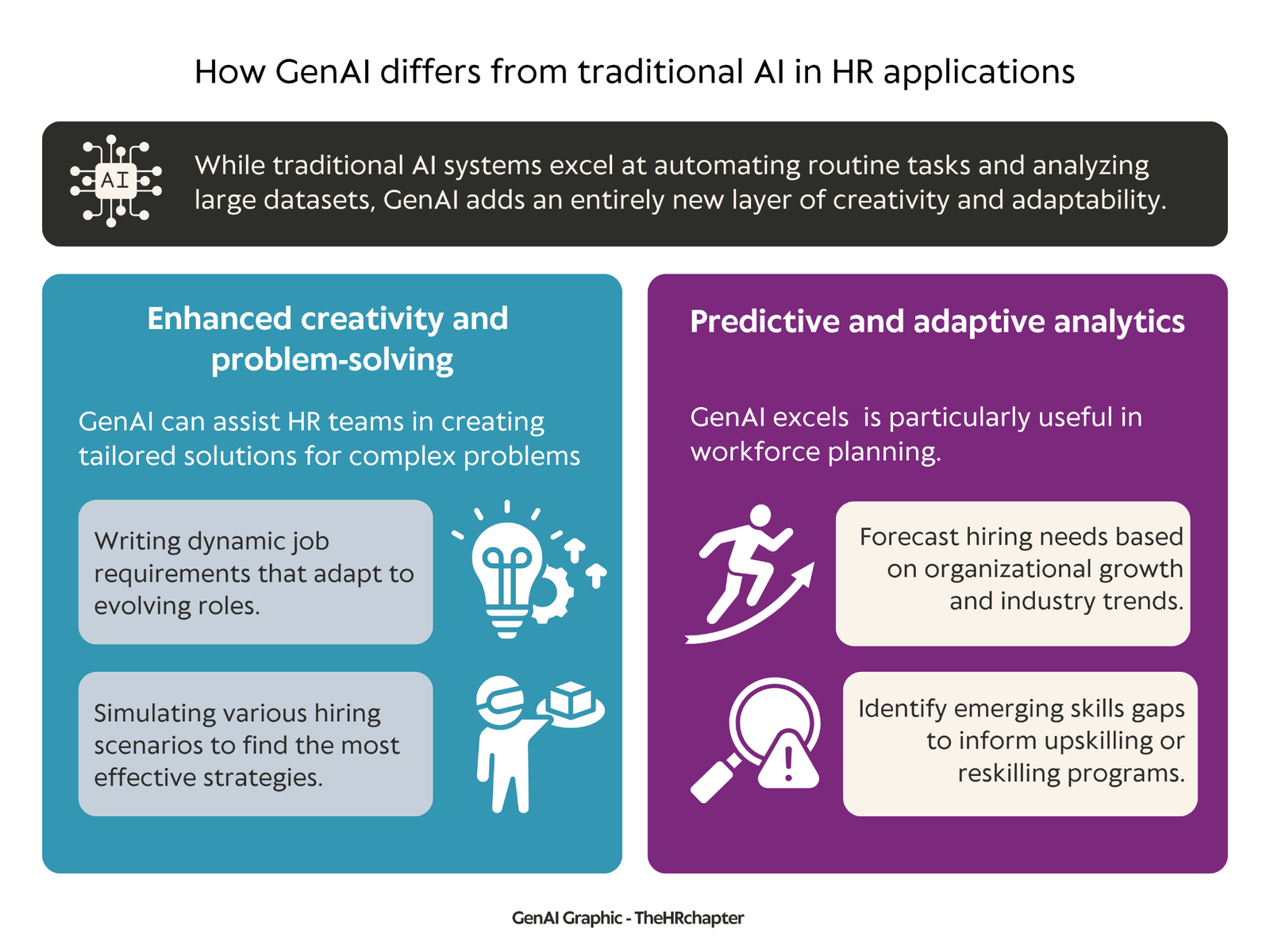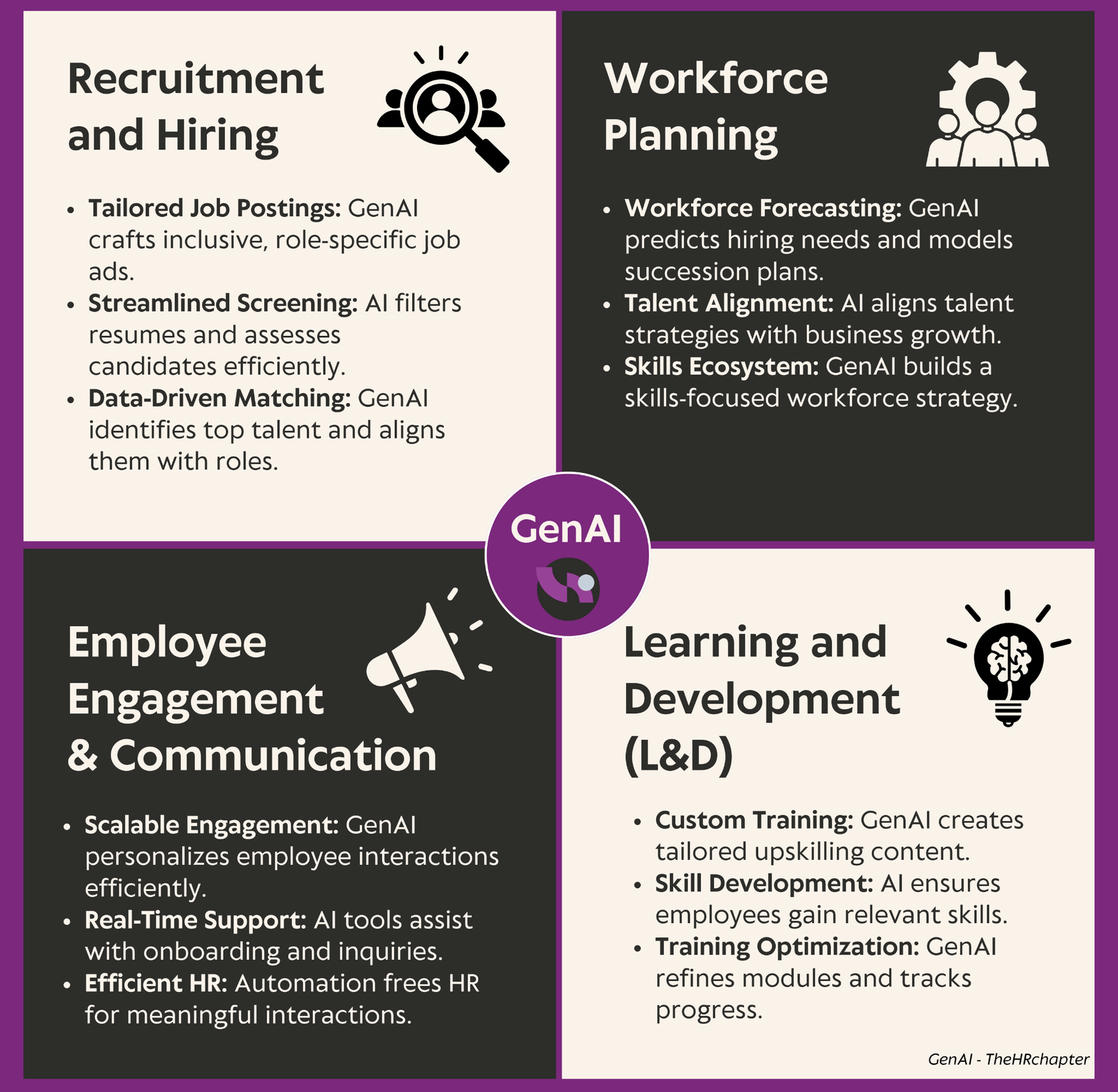GenAI for HR efficiency and Workforce Planning: Transform HR with Generative AI and HR Technology.

The HR profession is undergoing a major transformation driven by the adoption of Generative AI (GenAI). A Bain & Company study reveals that GenAI can save HR teams 15–20% of their labor time by automating tasks and enhancing operations. This technology is reshaping workforce management by combining data-driven insights with human creativity, enabling HR to address challenges in recruitment, employee engagement, and workforce planning more efficiently and effectively.
Unlike traditional AI, which executes predefined tasks, GenAI can generate, summarize, and personalize content in ways that mimic human thought. Its ability to create tailored solutions makes it essential in an industry where personalization and strategic alignment are key.
TheHRchapter explores how HR leaders can harness GenAI to enhance efficiency and elevate their strategic contributions to their organizations. From improving the speed and accuracy of crafting job descriptions to personalizing candidate outreach and predicting workforce needs, GenAI offers transformative tools to address HR’s most pressing challenges.
Understanding Generative AI in HR
What is Generative AI?
Generative AI (GenAI) is a type of artificial intelligence designed to generate content, such as text, images, or even code, based on input prompts. Unlike traditional AI systems that rely on predefined algorithms to execute specific tasks, GenAI leverages large language models (LLMs) to analyze patterns, interpret data, and produce human-like responses or solutions. This adaptability allows GenAI to address a wide range of challenges in HR, from streamlining administrative work to enabling more personalized employee interactions.
In HR, GenAI tools like ChatGPT, Jasper, and other AI-powered platforms are already being used to:
- Draft job descriptions: Generating tailored and inclusive postings that match required skills with organizational goals.
- Personalize candidate communication: Crafting unique responses and outreach strategies for thousands of applicants.

By combining these advanced capabilities with the human touch, GenAI is uniquely suited to help HR professionals tackle the growing demands of their roles while driving both efficiency and strategic impact. As organizations adopt this technology, HR teams can move beyond operational duties to become critical enablers of business transformation.
Applications of GenAI in HR
Generative AI (GenAI) is reshaping HR functions by automating repetitive tasks, enhancing personalization, and providing actionable insights. From recruitment to workforce planning, the technology offers transformative capabilities that drive efficiency and strategic impact.
1. Recruitment and Hiring
GenAI revolutionizes recruitment by automating job descriptions and candidate screening. Tools powered by GenAI can generate dynamic, inclusive job postings tailored to specific roles, while also filtering resumes and providing AI-driven candidate assessments. By analyzing large datasets, GenAI identifies top talent faster and matches candidates with roles more effectively.
2. Employee Engagement and Communication
AI-driven chatbots and virtual HR assistants provide real-time support, guiding employees through onboarding and addressing inquiries with conversational workflows. These tools not only streamline administrative processes but also free HR professionals to focus on meaningful, face-to-face interactions during critical employee moments.
3. Workforce Planning
GenAI supports workforce planning by synthesizing structured and unstructured data to predict future hiring needs, identify skills gaps, and model succession scenarios. Its predictive analytics help HR leaders anticipate talent requirements aligned with business growth, enabling more strategic decision-making.
4. Learning and Development (L&D)
GenAI transforms L&D by creating personalized training programs and generating content for upskilling initiatives. With insights into individual learning preferences and organizational needs, AI-driven tools design targeted development plans, ensuring employees acquire relevant skills to stay competitive. HR professionals can also use GenAI to process feedback, refine training modules, and track progress with actionable insights.

By integrating GenAI into these areas, HR departments not only enhance efficiency but also position themselves as strategic enablers of organizational transformation. Whether through automating routine tasks or delivering data-driven insights, GenAI empowers HR to focus on what matters most: building an engaged, future-ready workforce.
Challenges Faced by HR Professionals Today
HR professionals face an array of challenges in today’s dynamic workforce landscape, many of which GenAI is well-equipped to address. Traditional recruitment and onboarding processes are often inefficient, requiring significant time and effort to sort through large pools of candidates and manage administrative tasks. For roles with well-defined skill sets, GenAI can streamline these processes by analyzing profiles and suggesting the most suitable candidates, drastically improving productivity. However, for novel or evolving roles, HR teams must carefully validate criteria to ensure fair and effective decision-making, particularly when dealing with incomplete or proprietary data sources.
Workforce planning is another complex area. Predicting talent gaps, forecasting future skills needs, and improving employee retention are critical yet challenging tasks. GenAI’s predictive analytics can identify trends and help HR strategize for long-term workforce needs. Beyond planning, employee engagement remains a persistent issue. Personalizing support and communication at scale is difficult, but GenAI tools—such as chatbots and tailored outreach solutions—can help HR teams provide meaningful interactions with employees while freeing up time for deeper engagement initiatives.
GenAI and Ethical Considerations
Despite these benefits, HR’s adoption of GenAI must address keyethical concerns. Managing sensitive employee data responsibly is of greatest importance, particularly in a regulatory environment that is constantly evolving. HR leaders must work closely with legal and compliance teams to ensure that GenAI systems align with data privacy standards. Bias in AI models presents another challenge; while AI has the potential to reduce bias in decision-making, poorly designed systems can inadvertently reinforce existing inequities. Proactive validation and transparency are essential to mitigate these risks.
Finally, successful implementation of GenAI requires thoughtful change management. As HR processes shift, teams must adapt to new workflows and technologies. Leaders must clearly define goals and invest in upskilling HR professionals to use GenAI effectively. By addressing these challenges with a balanced and responsible approach, organizations can unlock the transformative potential of GenAI while safeguarding fairness and trust.
Ready to transform your HR practices?
At TheHRchapter, we go beyond traditional executive search. By integrating transformative technologies like Generative AI (GenAI), we streamline recruitment processes, deliver data-driven insights, and enable highly personalized solutions. Our approach empowers HR teams to transition from operational tasks to strategic enablers, fostering future-ready workforces and driving organizational success.
TheHRchapter is your partner in elevating HR practices and identifying the right talent for your business. Whether it’s leadership acquisition, workforce planning, or leveraging GenAI for enhanced HR operations, we provide tailored solutions to meet your unique needs.
Spread the Word!
Enjoyed what you’ve read? Help others discover it too! 📢 Share this article and let’s keep the discussion going.
Related Reads: Check out these other Articles!
The Strategic Role of HR in Mergers and Acquisitions: Driving Smooth Transitions and Employee Alignment
The Strategic Role of HR in Mergers and Acquisitions: Driving Smooth Transitions and Employee Alignment…
HR’s Essential Role in Compliance and Due Diligence During Mergers
HR’s Essential Role in Compliance and Due Diligence During Mergers When we talk about mergers…
AI in Business Transformation: Moving Beyond the As-Is to the To-Be
AI in Business Transformation: Moving Beyond the As-Is to the To-Be Change is never easy….


